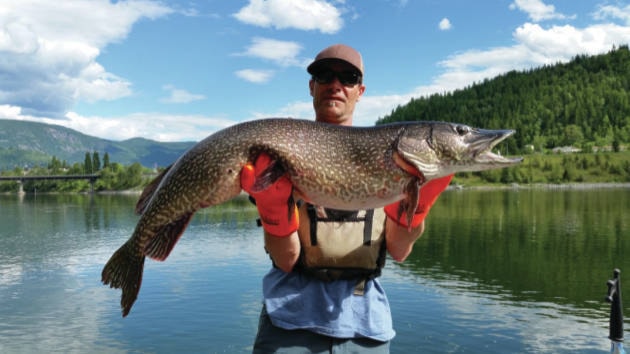There aren’t many places on the planet that boast the phenomenal fisheries we enjoy in the Kootenays, and in particular the Columbia River.
The fishing is unsurpassed, the natural beauty intoxicating. Yet, if there is one troubling aspect of the river that afflicts me between casts, it’s the increasing number of invasive species I tie into occasionally.
Anglers routinely catch species like walleye, bass, and brook trout, but recently, I caught a lake trout in the Salmo River and a pike in the Pend d’Oreille, and a friend watched a catfish swim by in the Columbia.
It’s getting worse, particularly with the northern pike’s intrusion into the Columbia. I don’t want to see one of the best rainbow-trout fisheries in North America turn into what the Box Canyon Reservoir of the Pend d’Oreille River looked like before the collective fisheries’ managers targeted and removed over 90 per cent (roughly 17,000) of the apex predators. The devastation to native species like cutthroat and bull trout, and even alien species like bass, was considerable.
But pike, like most invasive species, are difficult to control and almost impossible to eradicate. The only thing that stops them from overpopulating the stretch of river between Trail and Castlegar is the lack of suitable habitat. The largely free-flowing, oxygen-rich waters are great for rainbow trout, but not so much for pike. So they’ve set up shop in the slow and tepid waters of the Lake Roosevelt Reservoir around the mouths of the Kettle, Colville, and Spokane Rivers and have been found as far south as Hunter’s Creek.
Fisheries managers from the Washington Department of Fish and Game (WDFW) and the Colville and Spokane Tribes are throwing everything they can at the pike. Last fall, close to 900 pike were removed through gill-netting and electo-fishing, and from February to July, fisheries managers removed almost 1,100 pike. Since May 1, another 216 pike have been cashed in by anglers who receive a $10 bounty for every head returned to collection stations.
The bounty could be a money-making enterprise if not for a $590 cap set per angler. If managers were serious about ridding the Columbia of pike perhaps they would duplicate the Northern Pikeminnow Sport-Reward program of the Lower Columbia. The Bonneville Power Administration (BAP) offers a bounty on northern pikeminnow (a completely different species) from May 1-Sept. 30, which nets anglers tens-of-thousands of dollars annually, with the top-rod earning close to $120,000 in 2016.
Payments go up for the more pikeminnow an angler brings in: $5 each for the first 25 fish, $6 for fish 26-200, and $8 for 200-plus, and specially tagged pikeminnow nets the angler $500. It adds incentive and I imagine it’s not an unpleasant way to make extra cash.
Since 1990, anglers have removed over 4.5 million of the juvenile-salmon-eating pikeminnow, and WDFW estimates a 40 per cent reduction in the pikeminnow population.
Northern pike, meanwhile, have meandered some 500 miles from Flathead Lake, through various waterbodies and over a dozen dams, into Lake Pend Oreille, the Pend d’Oreille River and ultimately the Columbia. Pike are a robust fish, and their population is now growing rapidly in Lake Roosevelt. Potentially, the alien species will breach the Grand Coulee and Chief Joseph Dams, continue its march into the Okanagan River, into Christina and Okanagan Lakes, into the lower Columbia, and it’s tributaries, where pike will pose as much of a threat to ESA listed salmon and steelhead as the pikeminnow.
On the Canadian side, the fight against this invasive species is far from over. Stopping them from breaching dams in the Canadian portion of the Pend d’Oreille River would have seemed the easiest solution, but there have been few studies done and no action was taken until pike reached the Columbia - and by that time it was too late.
Northern pike are spawning in the Columbia and will likely move into the Arrow Lakes Reservoir, if they haven’t already done so. While not ideal habitat, pike can adapt and wreck havoc on the population of Kokanee, rainbow trout and other species, and they will be more difficult to suppress in the expansive reservoir.
For fish managers in the West Kootenay and in Washington State to be successful, funding like the kind BAP gives to the Pikeminnow Reward Sport-Reward program is essential. Partners like BC Hydro, Teck, and Columbia Basin Trust have helped fund initiatives and studies but more will be required.
According to Holly McLellan, fisheries biologist from the Colville Tribe of Indians, “No native fishery is safe from the pike. They can eat fish up to three-fourths their length. They can disturb the whole ecosystem.”
Stomach contents from the pike caught in the Columbia and Lake Roosevelt have included hatchery rainbows, wild rainbows, kokanee, burbot, suckers, whitefish, juvenile sturgeon, bass, walleye, crayfish, sculpins and other pike as well as ducks and mice.
“They eat everything,” McLellan said.
Remember that next time you’re enjoying a day on the water.
